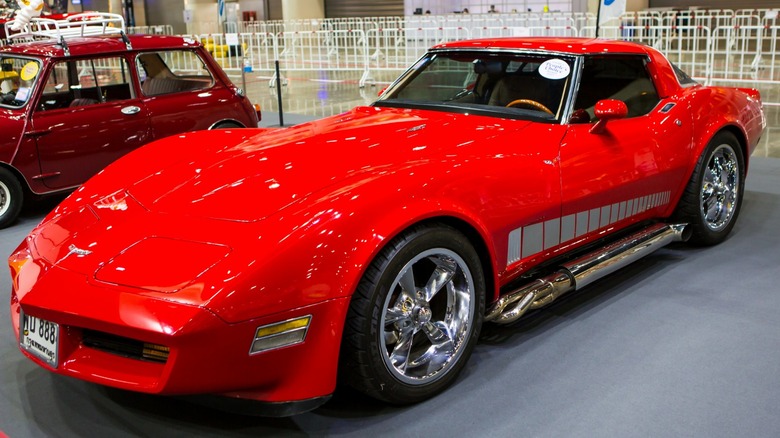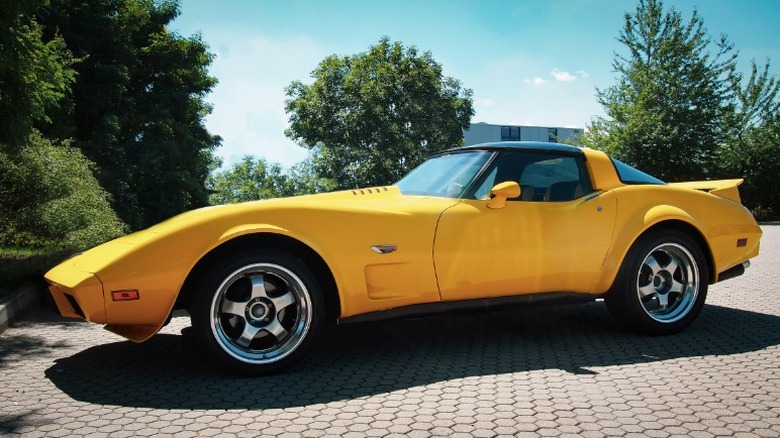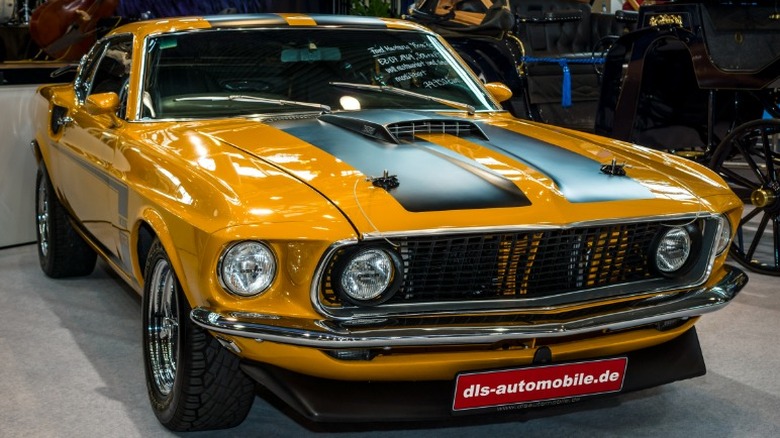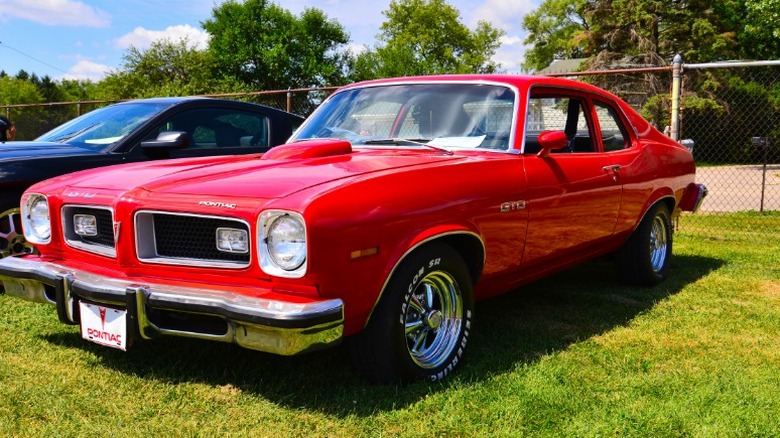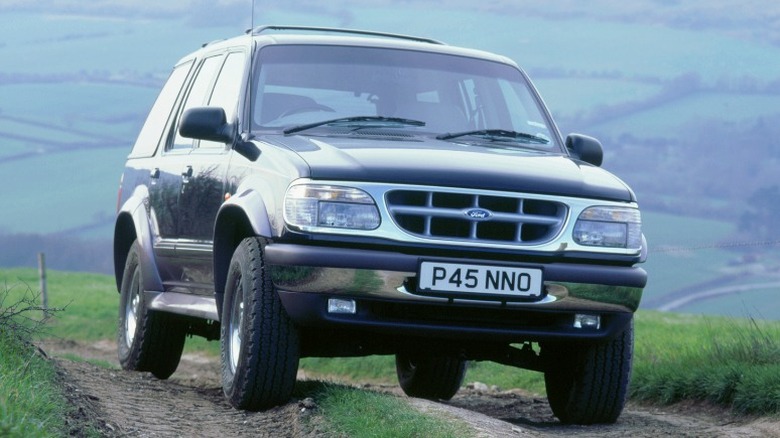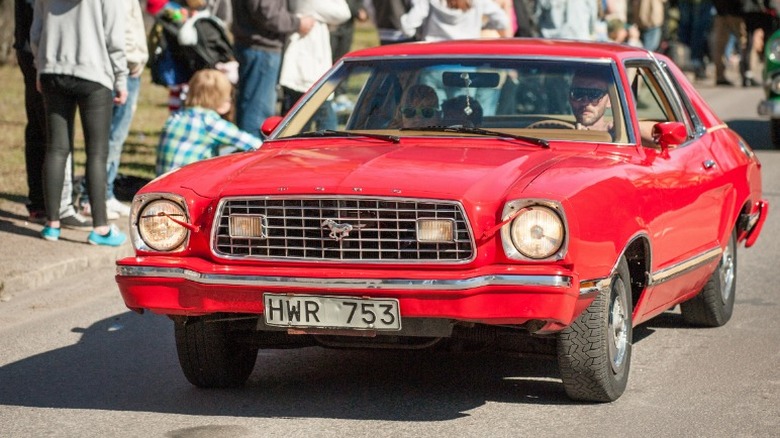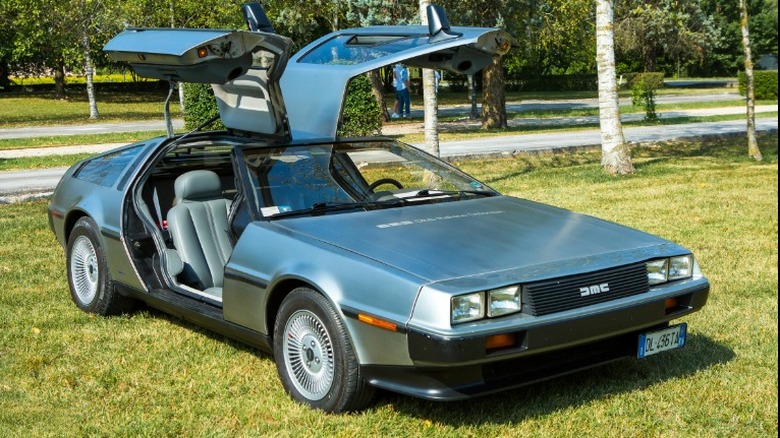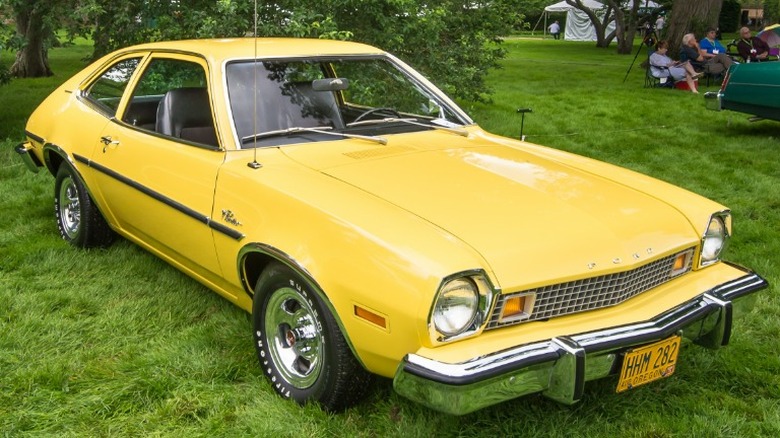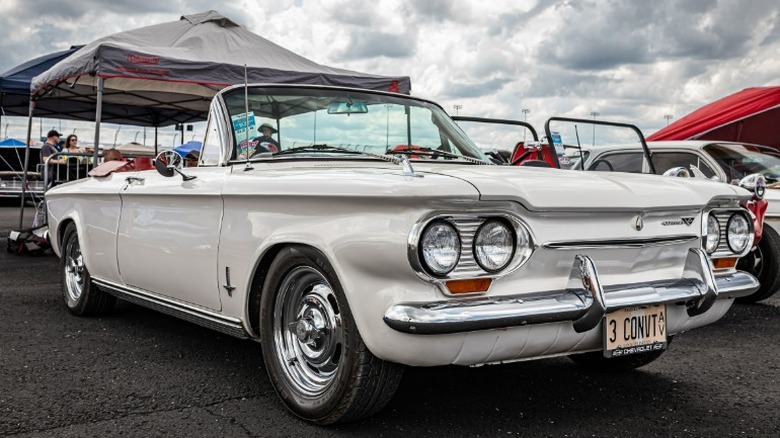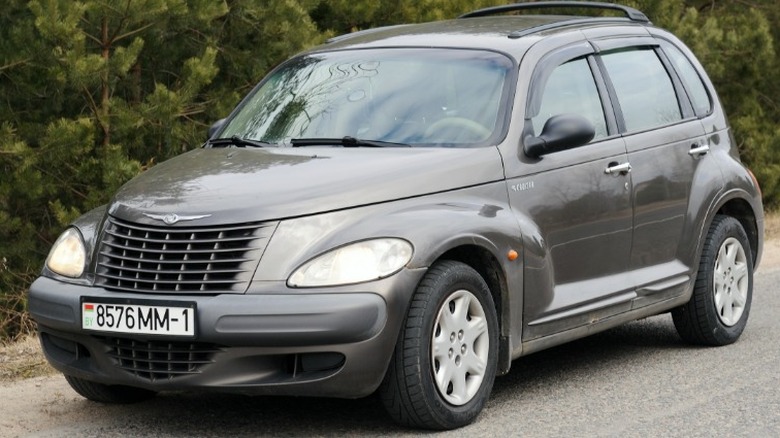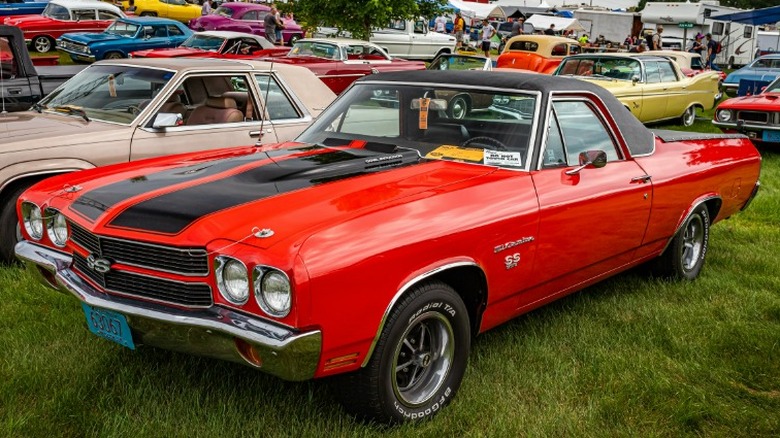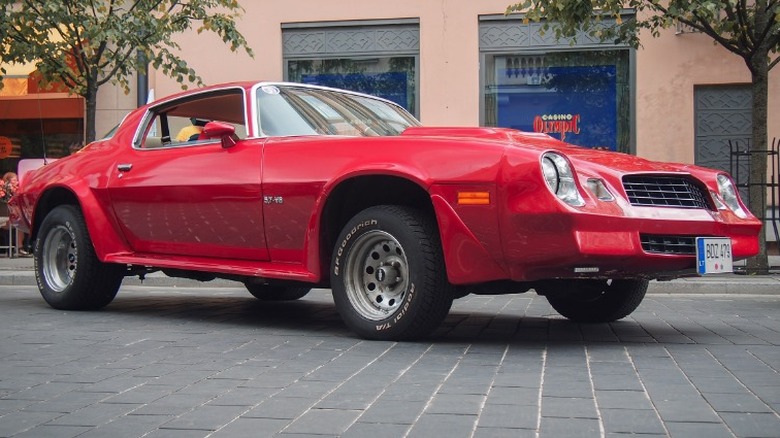12 Classic American Cars That Are A Total Waste Of Money
The history of the American automobile is full of innovation, creativity, and state-of-the-art engineering and technology. Although many excellent vehicles are designed and produced outside the U.S., American cars seem to have their own unique character, driven by the demands of the buying public. Many of the cars built with high-quality materials and groundbreaking features become classics, maintaining their value for years and in some cases selling for many times their original MSRP. Rare and iconic sports and muscle cars such as the Ford Mustang, Chevrolet Camaro, Dodge Charger and Challenger, and Chevrolet Corvette are some of the most sought-after American classic cars by collectors and enthusiasts.
However, at times, American automakers have produced some of the industry's least innovative, problem-ridden, unreliable, maintenance nightmares. In some cases, the models suffer from a poor design with hideous styling, a propensity to rust, and substandard build quality. Some traditional high-performance cars became victims of the 1970s U.S. government strict environmental emissions mandates, losing the power that once made them great. Although a few classic cars with a history of high maintenance or poor performance still fetch a high resale price, often due to low original production and current limited availability, most are a poor investment. Either the maintenance expense is exorbitant, the value depreciates with time, or a combination of both makes them a total waste of money.
1980 Corvette 305 California
Emissions requirements implemented by the U.S. government and California's strict environmental mandates in the 1970s had a significant impact on vehicle power output, particularly muscle cars. The California emissions requirements were so stringent that GM considered discontinuing Corvette sales in the state for the 1980 model year. Before the mandates, GM offered buyers several engine choices for the Corvette, America's best-selling sports car, including both small-block and big-block configurations. However, by 1974, the big-block options completely disappeared, and most of the small-block engines were detuned to comply with the new standards.
The GM solution for California was the Corvette 305, a model sold only in the state fitted with a single engine option, the LG4 305 cubic-inch V8, mated to a three-speed automatic transmission. No manual transmission was available. Depressing the clutch on a manual transmission causes a spike in pollution output, making it more difficult than the automatic to pass an emissions certification test.
The special edition 2-door fastback coupe Corvette that GM manufactured for California in 1980 featuring the 305 cubic-inch V8 produced a paltry 180 hp at 4,200 rpm and 255 lb-ft of torque at 2,000 rpm. The LG4 generated slightly more power than the original 1953 Corvette fitted with a 235 ci "Blue-Flame" Stovebolt-Six cylinder (150 hp). The estimated acceleration of the Corvette 305 "California" was 0 to 60 mph in a disappointing 9.3 seconds, reaching the quarter mile in 17 seconds. Although the top speed of the Corvette, sans speed governor, was rated at 122 mph, federal government regulations restricted the speedometer to 85 mph.
1982 Camaro Iron Duke
The early 1980s were rough on muscle car fans when the impact of tightening fuel economy standards and vehicle emissions took the punch out of performance V8s. Engines were detuned and, in some cases, big-block configurations were discontinued.
At General Motors, Camaro's chief engineer Tom Zimmer and his engineering team decided to focus on the third-generation Camaro's handling rather than power output. Instead of switching to a front-drive setup like many other GM vehicles, they kept the rear-wheel-drive and revised the suspension. The old rear leaf springs were replaced with coils, and the double control arms were substituted with a pair of struts and springs up front. The suspension improvements along with fine-tuning the F-car's unibody resulted in a 470-pound weight reduction and a 0.83 g on the skidpad. Motor Trend called the Camaro's dynamic handling about the best available in 1982.
Chevrolet's best-performing Camaro in 1982 was the Z28, equipped with a 5.0L V8 and four-speed manual transmission, producing 145 hp and a maximum torque of / 240 lb-ft. The high-performance Camaro accelerated to 60 mph in a lethargic 9.1 seconds, reached the quarter mile in 16.9 seconds, and achieved a top speed of 106 mph. While the 1982 Z28 performance was disappointing, the base model Camaro equipped with the smallest, least powerful 2.5-liter, four-cylinder "Iron Duke" producing 90 hp and connected to a low-tech three-speed automatic, offered an even more pathetic performance. The Iron Duke Camaro accelerated to 60 mph in about 20 seconds. Some critics questioned if the poor-performing car even warranted the Camaro nameplate.
1969 Ford Mustang Boss 302
Ford has a long history of manufacturing reliable engines. However, the Mustang Boss 302, was one of the few exceptions. The 302 ci V8 engine in the Mustang developed a reputation for cracking or outright failed pistons resulting in significant internal damage after a mere 20,000 miles.
Feeling the pressure of stiff competition from a new Chevrolet Camaro Z28 in 1969, Ford developed a stunning new Mustang homologated to qualify for the SCCA Trans-Am championship. It featured a high-rpm 5.0-liter V-8 (the series' engine size was limited to 305 cubic inches) and improved handling. Ford's basic 302-cubic-inch V8 engine block had already proved successful in powering a race car at the required high rpm rate with wins at Le Mans in 1968 and 1969. However, Ford looked for performance improvement. The automaker retooled the heads from the 351 cubic-inch Cleveland V8 and added them to the 302 along with a solid lifter valvetrain.
The street version of the Boss 302 generated 290 hp and 290 lb-ft of torque, accelerating the Mustang to 60 mph in an impressive 6.9 seconds, reaching the quarter mile in 14.6 seconds. To improve handling, Ford upgraded the Boss 302 with stiffer springs, additional shock tower bracing, more robust spindles, custom-tuned shock absorbers, new anti-roll bars, and F60-15 tires. According to Hemmings, resale prices for the 1969 Ford Mustang Boss 302 range from $53,000 at the low end to $160,000 at the high end with an average of $94,000. However, the engine problems make the Boss 302 a poor investment at any price.
1974 Pontiac GTO
Many automobile historians and car enthusiasts consider the 1964 Pontiac GTO the first "muscle" car. The formula of placing a large-displacement engine in a relatively small body gave the GTO (and other muscle cars to follow) exceptional performance in a straight line but with little attention paid to handling through the turns. In the late 1960s American car manufacturers produced a plethora of high-performance muscle cars with the same formula, such as the Ford Mustang, Chevrolet Camaro, Plymouth Barracuda, and Pontiac Firebird.
However, during the early '70s, the energy crisis, stricter emissions standards, and steeply rising insurance rates for young drivers took their toll on U.S. muscle car sales. The Pontiac GTO was no exception. GTO sales declined from 72,287 in 1969 to 40,149 in 1970 and then plummeted to 10,532 in 1971. Only 5807 were sold in 1972 as a LeMans option package.
After declining sales again in 1973, Pontiac changed the GTO for 1974 to a platform based on the Ventura X-body. The automaker offered only a single engine, the L76 350ci four-barrel that cranked out 200 hp at 4,400 rpm and 295 lb-ft at 2,800 rpm. Pontiac offered buyers three transmission options: the standard M11 three-speed manual, the optional M20 four-speed manual, and the optional M38 automatic transmission. Motor Trend tests showed an acceleration to 60 mph for the 1974 GTO of 9.4 seconds and through the quarter mile in 16.5 seconds at 84 mph, hardly impressive numbers. Some enthusiasts still consider the car nothing more than a glorified Chevy Nova.
1996 Ford Explorer
Ford began production of the Explorer in 1990, and by 1996 the SUV had become one of the automaker's best-selling vehicles. The company offered the Explorer XLT with four-wheel drive powered by a 4.0-liter V6 OHV (12 valves) engine producing 160 hp and 129 lb-ft of torque mated with a five-speed manual gearbox. The XLT accelerates to 60 mph in 10.6 seconds, reaches the quarter mile in 16.2 seconds, and achieves a top speed of 124 miles per hour.
In 1996, Ford also offered the Explorer with a 5.0-liter 16-valve V8 featuring an iron block and aluminum heads and an EEC-IV engine-control system with port fuel injection. The V8 generated 210 hp at 4500 rpm and 280 lb-ft of torque at 3500 rpm. Available in two-wheel or all-wheel drive models with a limited-slip differential, the Explorer accelerated from o to 60 mph in 9.4 seconds and reached the quarter mile in 16.8 seconds at 82 mph.
The Ford Explorer's success in the competitive SUV market for more than 30 years was due to the vehicle's iconic styling, versatility, and four-wheel drive capability. It was favored by off-road enthusiasts as well as suburban families. However, the early versions, including the 1996 model year, were plagued by corporate engineering failures and flawed executive decisions that forever damaged the reputations of both Ford and Firestone and ended their long-time relationship. Tire separations that occurred on the Explorer as early as 1996 resulted in a much higher-than-expected number of rollovers, crashes, and over 200 deaths.
Ford Mustang II
The Ford Mustang II is often described as symbolizing the Malaise 1970s era of the American automobile. Produced from 1973 to 1978, Ford offered the Mustang II with a body style typical of a generic sedan, a significant departure from the sporty coupes and convertibles of the previous generation. The automaker based the new design on the Ford Pinto, creating a smaller, more fuel-efficient vehicle to compete with imports that had gained popularity stimulated by the fuel crisis.
Three different engine options included a 2.3-liter Lima I4, a 2.8-liter Cologne V6, and a 4.9-liter Windsor V8, none of which met the performance expectations of traditional Mustang enthusiasts. The four-cylinder and V6 engines cranked out a paltry 92 and 105 hp, respectively. The underpowered V8, generating 140 hp, accelerates the Mustang from 0 to 60 mph in a lethargic 9.6 seconds and reaches the quarter mile in 17.5 seconds at a speed of 78 mph.
According to CJ Pony Parts, "From its exterior to design flaws to its lackluster performance numbers, the Second Generation is a period of time that many Mustang fans view as a black eye of the otherwise riveting history of their favorite vehicle. With the wonderful amenities and technological innovations in the years that followed, it is common for classic automotive supporters and muscle car aficionados alike to cast a dark shadow over the Mustang II entirely." Although Ford built more than 1.1 million Mustang IIs over a five-year production run, today, it is nearly impossible to find one in good condition.
1981-1982 DeLorean DMC 12
When it was first introduced, the DeLorean DMC 12 design was revolutionary. The innovative styling with a sleek stainless-steel body, gullwing doors, and new production techniques promised to provide the buyer with a sports car like no other. The DeLorean is perhaps best known for its role in the "Back to the Future" movie series (starring Michael J. Fox in the role of Marty McFly) as the time machine created by Dr. Emmett "Doc" Brown (played by Christopher Lloyd).
However, the DeLorean also become famous from its brief scandalous history involving John Z. DeLorean's rapid rise to the heights of the automotive industry managing GM divisions Pontiac and Chevrolet, building a car company, and his subsequent plummet to rock bottom after a controversial drug trafficking sting.
Perhaps the most significant factor in the demise of the DeLorean after only two years of production was the lack of power for a car in its price range. DeLorean equipped the DMC12 with a mid-mounted 2.8-liter Peugeot-Renault-Volvo (PRV) V6 producing 130 bhp at 5500 rpm and 162 lb-ft torque at 2750 rpm. The sports car accelerated to 60 mph in a lethargic 10.5 seconds, reached the quarter-mile mark in 17.9 seconds at 76.5 mph, and took 40 seconds to reach 100 mph. The DeLorean performance compares well with a 1981 Porsche 924 that produces 123 hp and accelerates to 62 mph in 11.0 seconds. However, the Porsche had an MSRP of $17,090 to $21,820, while the DeLorean was listed for $26,000.
1975 Ford Pinto
Introduced in the early '70s when auto buyers looked for subcompacts with excellent fuel economy, the Ford Pinto showed great promise. Initiated in 1971 by Lee Iacocca of Ford Mustang fame, the Pinto was the automaker's first subcompact car. The styling was a scaled-down variation of the Mustang and the name was meant to capitalize on the pony-car craze. Produced until 1980, Ford offered the Pinto in a 2-door fastback, a 3-door hatchback, and a 2-door station wagon body style.
During the early years, Ford fitted the Pinto with two four-cylinder engine options: a 1.6-liter generating 75 hp and a 2.0-liter with 100 hp. Although the power output was low, both engines gave the car that weighed only about 2,000 lbs reasonable performance and the fuel efficiency buyers were looking for at 20.6-24.7 mpg city/highway and 20.2 combined. Sales were strong for the Pinto from the very beginning, and with the 1970s energy crisis sales skyrocketed. Ford sold 544,209 Pintos in 1974, reached a total sales figure of 2.3 million units by 1976, and more than 3 million in total by 1980 when the car was discontinued.
However, numerous accidents in which Pintos exploded in a fire when hit from behind, resulting in an estimated 180 deaths, instilled fear in potential buyers. Ford was aware of the fuel tank flaw before the Pinto went to market. However, the company conducted a cost/benefit study that suggested it would be less expensive to pay liability for burn deaths than fixing the problem. The decision cost Ford millions in lost sales.
1960 Chevrolet Corvair
When Chevrolet introduced the Corvair in 1960, it was the only American-designed automobile using a rear-mounted, air-cooled engine. Its sporty good looks and affordable price made it a reasonable alternative to more expensive sports cars. The Corvair's unique style was copied by several European automakers including BMW in the 2002 model.
The naturally aspirated Boxer flat-six horizontally opposed 2.3-liter engine was made with aluminum heads, crankcase, and individual iron cylinder barrels. The inherently balanced flat-six layout meant that no crankshaft counterweights were required, which, along with the aluminum transaxle, reduced the drivetrain weight. The absence of a driveshaft and the air-cooled design lacking a radiator or water pump also contributed to the lightweight of only 2414 pounds. The Corvair produced 80 bhp at 4400 rpm and a maximum torque of 125 lb-ft at the same rpm, sending power to the rear wheels via a three-speed Manual gearbox.
A suspension with coil springs both in the front and the rear gave the Corvair its controversial handling and drum brakes at all four corners provided braking power. Although the Corvair design was innovative, the combination of rear-engine layout and swing-axle rear suspension placed nearly 60% of its weight over the rear wheels, causing the Corvair to spin out violently through the turns and risk a rollover. Ralph Nader highlighted the Corvair faulty rear suspension system defects in his book, "Unsafe at Any Speed" published on Nov. 30, 1965. The publicity helped spell the end of Corvair. Sales declined from 235,500 units in 1965 to a mere 15,400 in 1968.
2001 Chrysler PT Cruiser
The appeal of an affordably priced novelty car ran high when the Chrysler PT Cruiser was first released, but its popularity wore thin quickly. Although the miniature minivan seemed innovative at the time, buyers lost interest in the retro-styled design. Powered by a naturally aspirated 2.4-liter DOHC inline-four with balance shafts producing 150 hp proved just adequate performance for the "hatchback" weighing 3,120 pounds. Chrysler offered the PT Cruiser with a five-speed manual or four-speed automatic transmission, and the miniature special-purpose vehicle accelerated to 60 mph in a respectable 8.6 seconds. The fuel efficiency of 20/26 mpg city/highway combined with a 15.0-gallon fuel tank made city driving and cross-country cruising economical.
Perhaps the most impressive feature of the PT Cruiser was the available interior space for such a small vehicle. The rear twist-beam axle with a Watts linkage design helped create the spacious cargo area. All the seats (except the driver's seat) could be folded or removed, opening up a maximum volume of 65 cubic feet in the cargo area and a total volume of nearly 120 cubic feet, not unlike a typical SUV.
When Chrysler released the PT Cruiser in 1991, the automotive media were impressed. Motor Trend awarded the mini truck its Car of the Year award. Car and Driver placed it on its "10Best Cars" list, praising the car's style, handling, and versatility. However, by 2009, the glimmer of the new Cruiser design had faded, and sales plummeted from a peak of nearly 145,000 to 18,000 and then just 9,400 in 2010.
Chevrolet El Camino SS
Chevrolet first introduced the El Camino car-truck hybrid as early as 1958, inspired by the Ranchero, which Ford had released two years earlier. A combination of a sedan and a small pickup truck built on the Brookwood wagon platform offered the body style and options available on the Impala sedans. The El Camino featured the same Impala "cat's eye" taillights lurking below wide-spread rear fins. Chevrolet advertising claimed it was "the most beautiful thing that ever shouldered a load? It rides and handles like a convertible yet hauls and hustles like the 'workingest' thing on wheels."
A more robust version based on the Chevelle platform (GM's legendary A-body platform) came out in 1964 and remained until the El Camino was discontinued in 1987. In the late '60s, the muscle car mania was peaking and the formula of a big-block engine in a small body had been refined by several automakers. The emissions-control malaise was still in the future, albeit just a couple of years away.
In 1968, Chevy released its El Camino muscle car editions featuring 307, 327, and 350 cubic-inch engines with either two- or four-barrel carburetors. In 1970, the SS396 was powered by a 402, and the even bigger big-block 454-cubic-inch LS6 V8. Although the El Camino matched its competitors for pure horsepower, all that power going to the rear wheels with very little weight over them made the vehicle a challenge to handle. The car-truck hybrid performed better with a full load in the cargo bed.
1975 Chevrolet Camaro
Like so many muscle cars of the 1970s, the Camaro became a victim of the oil crisis. In 1975, Chevrolet reduced the number of engine options to three, a six-cylinder and two 350 CID V8s. The L22 I6 250ci produced 105 hp at 3800 rpm and 185 lb-ft of torque at 1200 rpm, while the L65 350ci generated 145 hp at 3800 rpm and 250 lb-ft of torque at 2200 rpm. The automaker also detuned the top performing mill, the LM1 4V 350 CID V8, and added a new catalytic converter to the Camaro's exhaust system, reducing the output to a disappointing 155 hp. Chevrolet's hottest Camaro LT trim with the 350 CID V8, accelerated to 60 mph in a disappointing 11.0 seconds and reached the quarter mile in lackluster 17.4 seconds at 77.6 mph.
With the energy crisis still a recent memory, in 1975, car buyers maintained their adjusted priorities when selecting a new car. Fuel efficiency superseded power output. As a result, the Camaro six-cylinder models became best-sellers. While the total production of Camaros reached 145,770 units in 1975, Chevrolet produced 29,749 six-cylinder models, many more than it had in the early 1970s.
Although Ford reacted to the energy crisis by converting the mighty Mustang into a downsized economy car, the Mustang II, General Motors stuck with the classic look of the second-generation Camaros. The 1975 Camaro still looks like a muscle car. However, how many of today's classic car enthusiasts want a Camaro with a muscle car appearance but the anemic performance of a fuel-efficient engine inside?
